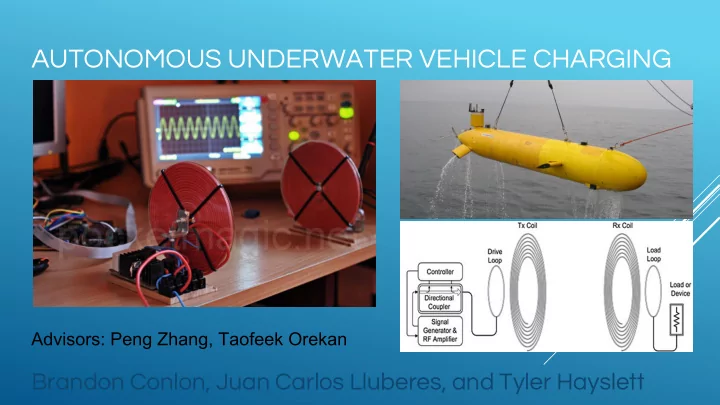

AUTONOMOUS UNDERWATER VEHICLE CHARGING Advisors: Peng Zhang, Taofeek Orekan Brandon Conlon, Juan Carlos Lluberes, and Tyler Hayslett
SUMMARY ● Our section of the wave power team will focus on wireless power transfer (WPT) through seawater. ● This is to aid in supplying AUVs with power in their operating environment. ● We will test efficiency of WPT through seawater over a range of distances, frequencies, and power factors.
BACKGROUND ● Use of AUVs is limited by onboard power storage; it’s costly to dispatch crews to replace battery packs or refuel. ● Extension of AUV capability must be effected with new powering schemes ● Distributed network of wave generators to power AUVs is complicated ● Direct electrical connections are frequently used and they pose two main problems: ● Need to recall AUV to buoy or tether it limits the AUV’s useful range ● Even high end marine connectors have short lifetimes
POWER NEEDED ● Typical AUV battery storage composed of 1.5 kW packs (Bluefin Robotics) ● Recharging an AUV of any capacity would require a significant rate of transfer.
PRELIMINARIES ● Preliminary research suggests saltwater attenuates EM waves rapidly. ● Attenuation more severe at high frequencies. ● This poses a serious problem for long distance WPT in the ocean environment. ● For this reason we are testing a resonantly coupled WPT system.
RESONANT POWER TRANSFER ● Since inductive coupling is a very short range method of WPT, and radiative or directional beam (lasers or microwaves) would be quickly absorbed by the ocean, resonant WPT is of natural interest. ● Tests in air have been demonstrated at up to 10 times coil diameter.
SOLUTION ● Our main goal is the construction of a system that allows for efficient transfer of wireless power over distances. ● Resonant WPT is still a developing technology, and so its efficiency operating underwater is not well described. ● We will test a resonantly coupled system in a simulated undersea environment. ● The test will hopefully allow us to design a microcontroller balanced system with functions that will change frequency and amplitude of wireless signal to compensate for changes in the coupling.
ALTERNATIVE SOLUTION ● Since water absorbs much of the EM waves in it it may do the same for magnetic fields. ● If the water absorbs enough of the signal energy to make long distance transmission unfeasible (2db/meter or more) our end system will not include the microcontroller. ● Since the proximity required to transfer reasonable amounts of energy will be small, WPT would be more easily done with simple inductive coupling. ● The AUV would dock to the generator, while this is less than ideal, it would still avoid high maintenance marine connectors.
PRELIMINARIES ● Shown is an air-gap coupled transformer. ● This is an approximation of our system for shorter distances (less than diameter of coil). ● This model is approx. 40% efficient For Vin = 20V @ 100 kHz, K = 1, R = 1 Ω, C = 10.5 nF, L = 24 µH
TESTING ● A rig structure will allow coils to be set at set incremental distances ● At each distance increment a logarithmic frequency sweep and linear power factor sweep will be performed. ● Efficiency trends will dictate optimal frequency and PF for final system. ● If promising combination is found, trip to ocean will be planned to test at longer distance. ● The test rig will be made from 1”*1” hollow square pvc to prevent erosion Side view of example rig.
TEST RIG ● Test rig will consist of a 30”*20”*16.5” plastic frame to be immersed in 30 gallon tote. Works out to around 25’ of 1”*1” pvc needed. ● Tank to be filled with water of same salinity as seawater. ● Coils will be waterproofed and attached to ⅛ ”plexiglass plates (or other non reactive material). ● Coils and correction circuitry will be driven by a bench signal generator. ● Frame will allow distance adjustments in linear increments of 1 cm demarcated by slits cut into the frame.
Schedule ● Finish rig setup by end of semester. ● Begin testing over intersession period. ● Have finished testing by early February. ● Use test data to finalize system design and order parts. ● Build and test system for demonstration.
QUESTIONS?
Recommend
More recommend